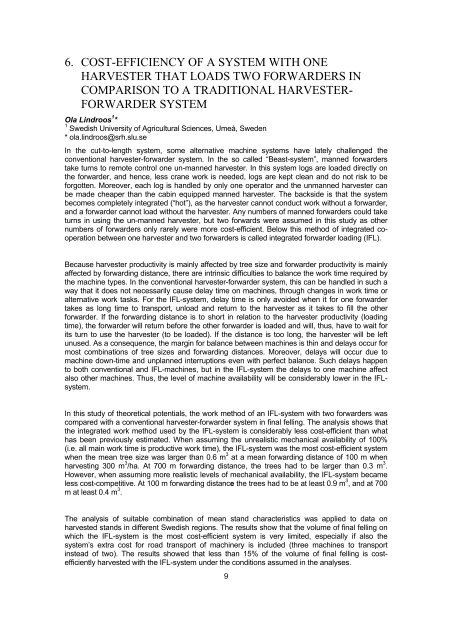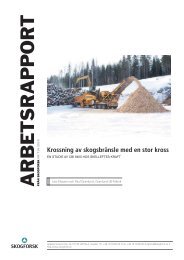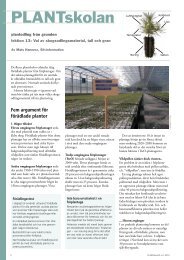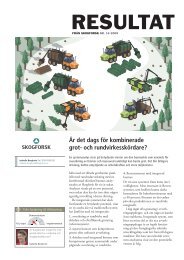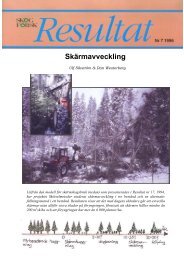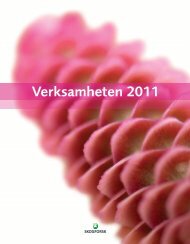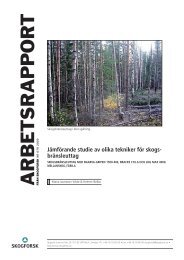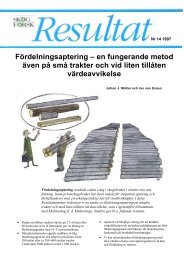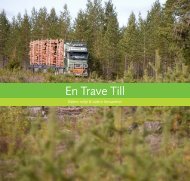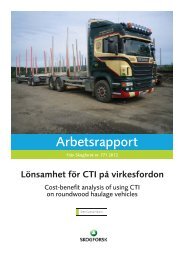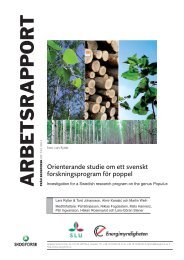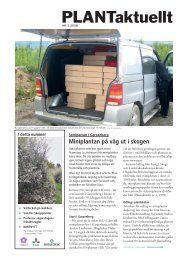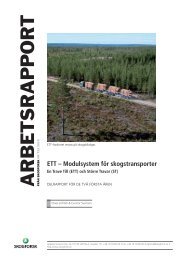Download pdf - Skog og landskap
Download pdf - Skog og landskap
Download pdf - Skog og landskap
Create successful ePaper yourself
Turn your PDF publications into a flip-book with our unique Google optimized e-Paper software.
6. COST-EFFICIENCY OF A SYSTEM WITH ONE<br />
HARVESTER THAT LOADS TWO FORWARDERS IN<br />
COMPARISON TO A TRADITIONAL HARVESTER-<br />
FORWARDER SYSTEM<br />
Ola Lindroos 1 *<br />
1 Swedish University of Agricultural Sciences, Umeå, Sweden<br />
* ola.lindroos@srh.slu.se<br />
In the cut-to-length system, some alternative machine systems have lately challenged the<br />
conventional harvester-forwarder system. In the so called “Beast-system”, manned forwarders<br />
take turns to remote control one un-manned harvester. In this system l<strong>og</strong>s are loaded directly on<br />
the forwarder, and hence, less crane work is needed, l<strong>og</strong>s are kept clean and do not risk to be<br />
forgotten. Moreover, each l<strong>og</strong> is handled by only one operator and the unmanned harvester can<br />
be made cheaper than the cabin equipped manned harvester. The backside is that the system<br />
becomes completely integrated (“hot”), as the harvester cannot conduct work without a forwarder,<br />
and a forwarder cannot load without the harvester. Any numbers of manned forwarders could take<br />
turns in using the un-manned harvester, but two forwards were assumed in this study as other<br />
numbers of forwarders only rarely were more cost-efficient. Below this method of integrated cooperation<br />
between one harvester and two forwarders is called integrated forwarder loading (IFL).<br />
Because harvester productivity is mainly affected by tree size and forwarder productivity is mainly<br />
affected by forwarding distance, there are intrinsic difficulties to balance the work time required by<br />
the machine types. In the conventional harvester-forwarder system, this can be handled in such a<br />
way that it does not necessarily cause delay time on machines, through changes in work time or<br />
alternative work tasks. For the IFL-system, delay time is only avoided when it for one forwarder<br />
takes as long time to transport, unload and return to the harvester as it takes to fill the other<br />
forwarder. If the forwarding distance is to short in relation to the harvester productivity (loading<br />
time), the forwarder will return before the other forwarder is loaded and will, thus, have to wait for<br />
its turn to use the harvester (to be loaded). If the distance is too long, the harvester will be left<br />
unused. As a consequence, the margin for balance between machines is thin and delays occur for<br />
most combinations of tree sizes and forwarding distances. Moreover, delays will occur due to<br />
machine down-time and unplanned interruptions even with perfect balance. Such delays happen<br />
to both conventional and IFL-machines, but in the IFL-system the delays to one machine affect<br />
also other machines. Thus, the level of machine availability will be considerably lower in the IFLsystem.<br />
In this study of theoretical potentials, the work method of an IFL-system with two forwarders was<br />
compared with a conventional harvester-forwarder system in final felling. The analysis shows that<br />
the integrated work method used by the IFL-system is considerably less cost-efficient than what<br />
has been previously estimated. When assuming the unrealistic mechanical availability of 100%<br />
(i.e. all main work time is productive work time), the IFL-system was the most cost-efficient system<br />
when the mean tree size was larger than 0.6 m 3 at a mean forwarding distance of 100 m when<br />
harvesting 300 m 3 /ha. At 700 m forwarding distance, the trees had to be larger than 0.3 m 3 .<br />
However, when assuming more realistic levels of mechanical availability, the IFL-system became<br />
less cost-competitive. At 100 m forwarding distance the trees had to be at least 0.9 m 3 , and at 700<br />
m at least 0.4 m 3 .<br />
The analysis of suitable combination of mean stand characteristics was applied to data on<br />
harvested stands in different Swedish regions. The results show that the volume of final felling on<br />
which the IFL-system is the most cost-efficient system is very limited, especially if also the<br />
system’s extra cost for road transport of machinery is included (three machines to transport<br />
instead of two). The results showed that less than 15% of the volume of final felling is costefficiently<br />
harvested with the IFL-system under the conditions assumed in the analyses.<br />
9


